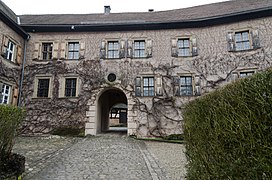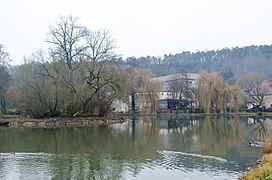Aschbach Castle
Aschbach Castle , also Baron v. Called Pölnitzsches Schloss , it is a baroque castle of the Pölnitz family in Aschbach , a district of the Upper Franconian town of Schlüsselfeld . The facility comprises a building complex with courtyards, residential buildings, stables and barns . The castle, its park and some outbuildings are under monument protection .
location
Aschbach Castle is located west of the Schlüsselfelder district of Aschbach on a slope about 10 meters above the town on the road to Burgwindheim (BA 20). Even if there are some green spaces behind the castle up the slope , the actual, approximately 5 ha large castle park is located down the slope across the street to the village. The palace and park are privately owned and cannot be visited.
history
A castle that was owned by a branch of the Pölnitz family stood at the current location before the Thirty Years War . It burned out completely during the war. General Hieronymus Christoph von Pölnitz , who was elevated to the status of a baron by Emperor Leopold I in 1670 , acquired the site from another branch of the family in 1652 and had the castle rebuilt in its current form between 1677 and 1697 using the foundations and walls that had remained standing. Under Marquard Karl Christoph Freiherr von Pölnitz, knight captain of the canton Steigerwald , the baroque interior was designed in the early 18th century. Major renovations took place from 1896 to 1904, and another renovation was carried out in 1976.
During the Second World War , paintings and other art objects from various museums were stored in Aschbach Castle, for example from Kassel and Bamberg, including works from the Hildebrand Gurlitt Collection , which later became known as the Schwabinger Kunstfund . After the Second World War, the castle served as a DP camp for the temporary accommodation of Jewish Poles who wanted to emigrate to Israel and who received training in agriculture and dairy farming in preparation for their future tasks in the kibbutz . In 1948 the camp was closed and the castle returned to the Pölnitz family.
Since the 1980s Nicolaus von Pölnitz has been breeding falcons on a large scale on the grounds of the castle , which he trained for hunting and sold to falconers , especially in Arab countries. In 2003 he kept 80 old falcons with which he bred 90 young falcons. Since he also at Falcon breeding gyrfalcon with Saker crossed, it came in 2010 at a trial for the 2005 revised bundesartenschutzverordnung that indigenous species to protect the holding of such birds of prey hybrids bans. The question of whether saker falcons are still a species native to Germany, however, no longer had to be clarified due to the death of the animals in question, and the proceedings were discontinued.
lock
The castle ( location ) is a two-story, two-wing sandstone block building with a hipped roof . The area is closed off from the street with an 18th century courtyard wall ( location ). A gate ( location ) with two stone pillars on which the coat of arms of the Pölnitz family is attached and with two wrought iron gate wings leads into a front courtyard ( location ) in which there is a fountain ( location ). Outside stairs lead to the entrances in the north and east wings. There is also a family coat of arms above the entrance to the east wing. The east wing has a passage into a rear courtyard ( location ), a round stair tower and an inner courtyard ( location ) with an arcade .
Other buildings on the castle grounds date from the 18th and 19th centuries: a stable building ( location ), an economic building ( location ), a barn with a gable roof ( location ) on the rear wall ( location ) and a large barn with a hipped roof ( location ) as the southern end of the system.
Castle Park
The palace park across the street has several differently designed parts. An 18th century gate ( location ) with two stone pillars carrying fruit baskets and two wrought-iron gate wings leads from the street into a baroque garden ( location ) with terraces, vases, busts on plinths, stairs and walls. In the baroque garden there is a garden pavilion ( location ) with a mansard hipped roof and a grotto fountain from the middle of the 18th century. On the street there is a gardener's house ( location ) with a gable roof and an associated barn with a half-hipped roof ( location ) from around 1860.
South of the baroque garden is the so-called Dorfsee ( Lage ), a pond with an artificial round island. A park laid out in the 19th century extends northwest of the Baroque garden ( Lage ).
Monument protection
The palace and palace park are entered separately as architectural monuments in the Bavarian list of monuments. The monument “Freiherrlich v. Pölnitzsches Schloss ”includes the actual castle building and its furnishings, as well as the outbuildings, the fountain in the front courtyard and the courtyard wall with portal. The monument “Freiherrlich v. Pölnitzscher Schlosspark ”include the baroque garden with entrance gate, garden pavilion and gardener's house with barn, the village lake with the artificial round island and the 19th century park.
Due to archaeological findings in the area of the castle from a presumably medieval to early modern predecessor building, the grounds of the palace and the baroque palace garden are also entered as a ground monument in the Bavarian list of monuments
Other buildings in the immediate vicinity of the castle that are related to the castle and are protected as individual architectural monuments include a former monastery building ( location ) from the 17th / 18th centuries. Century, to which a house chapel with roof turret from the 19th century is attached, as well as a forester's house ( location ) and a forestry office (forestry office, location ) from the 19th century.
Web links
- Aschbach Freiherrlich v. Pölnitzsches Schloss on www.drei-franken-info.de, the website of the municipal alliance Drei-Franken-Eck
- The history of Aschbach on www.aschbach-oberfranken.de, section: The Castle
- Castle of the Barons of Pölnitz in Aschbach on www.welt-der-wappen.de
Individual evidence
- ↑ Art collector Gurlitt had art stored in Aschbach . In: inFranken.de . ( infranken.de [accessed June 18, 2018]).
- ↑ At 300 km / h on the booty welt.de from July 6th, accessed on July 20, 2018
- ↑ Augsburger Allgemeine: Dead falcons do not need a judgment . In: Augsburger Allgemeine . January 20, 2010 ( augsburger-allgemeine.de [accessed June 18, 2018]).
- ↑ The Castle of the Falcons deutsches-adelsblatt.de
- ↑ List of monuments for Schlüsselfeld (PDF) at the Bavarian State Office for Monument Preservation, monument numbers D-4-71-220-42 and D-4-71-220-45
- ↑ List of monuments for Schlüsselfeld (PDF) at the Bavarian State Office for Monument Preservation, monument number D-4-6229-0013.
- ↑ List of monuments for Schlüsselfeld (PDF) at the Bavarian State Office for Monument Preservation, monument numbers D-4-71-220-41 , D-4-71-220-43 and D-4-71-220-44













